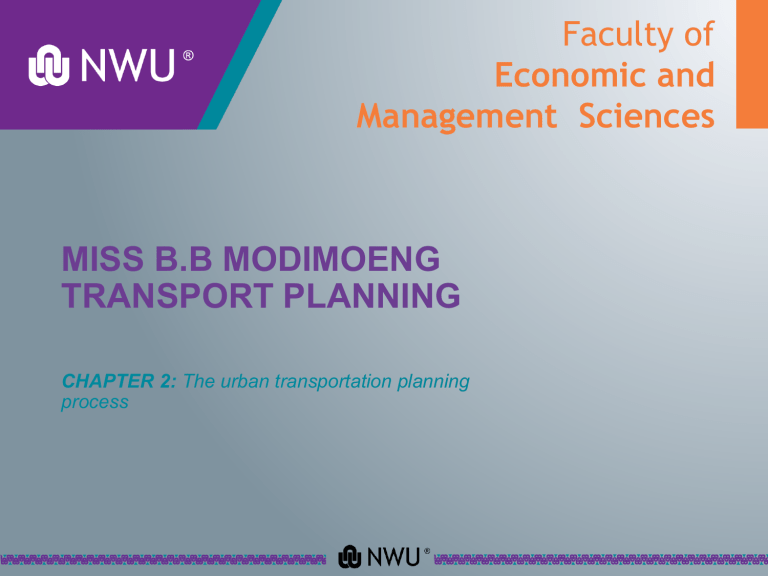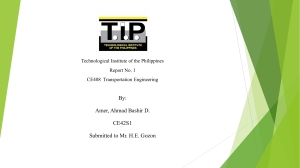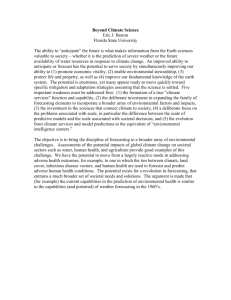
Faculty of Economic and Management Sciences MISS B.B MODIMOENG TRANSPORT PLANNING CHAPTER 2: The urban transportation planning process LEARNING OUTCOMES • Know and apply practically, the ten steps in the urban transportation planning process • Also take cognisance of the criticisms lodged against this process, with specific reference to the relevance to South Africa transport environment INTRODUCTION INTRODUCTION CONTINUING • Travel Demand Forecasting • The need for determining existing travel demand and future travel demand • Basic purpose of transportation planning is to match transportation supply with travel demand • Understanding of existing travel patterns is necessary to identify and analyse existing travel problems • Detailed data on current travel pattern and traffic volumes are needed for developing travel forecasting/prediction models • These predictions of future travel are essential for transportation planning for determining strategies accommodating future needs (Arun Chatterjee and Mohan M. Venigalla) • According to the Metropolitan council" • It allows planners to identify and analyse travel demand markets and produce estimates of future riderships TRAVEL DEMAND AND FORECASTING • Transportation forecasting is the process of estimating the number of people or vehicles that will use a specific transportation facility in the future. • Transportation forecasts can be utilized in a variety of different situations and with different modes of transport, • from estimating traffic volumes on a specific segment of road • or highway to estimating ships in a port or passenger volumes on a city’s buses TRAVEL DEMAND AND FORECASTING • How many trips will be made in the future? • Which transportation systems will become congested in the future? • How much ridership will a new transportation service attract? Travel demand forecasting and transportation planning • Three stages essential which are the essential part of transportation planning process • A survey and analysis stage • A prediction and plan formulation • An evaluation stage Travel demand forecasting and transportation planning The principal stages in the urban transportation planning process can be identified as : • The explicit formulation of goals and objectives • The collection of land use, population, economic and travel pattern data for present day situation • The establishment of quantifiable relationships between present day movements and the land use, population and economic factors • The prediction of land use, population and economic factors to the target date for the study and development of land use • The prediction of the origins, destinations and distributions of the future movement demands, using the relationships established for the present day situation and the predicted land use, population and economic factors (trip generation and trip distribution) • The prediction of the person movements likely to be carried by the different modes of travel at the largest date (modal split) • The development of alternative highway and public transport networks to fit the predicted land use plan and accommodate the estimated pattern of movements • The assignment predicted trips to alternative co-ordinated transport networks/systems (traffic assignment) • The evaluation of the efficiency and economic viability of the alternative transport networks in terms of both economic and social costs and benefits • The selection and implementation of the most appropriate transport networks CRUCIAL STEPS OF TRAVEL DEMAND AND FORECASTING • It is a multi-stage process, with different techniques that can be used at each stage • It involves five interrelated tasks as follows: • Break the area that requires prediction of future travel demand into study zones that can be accurately described by a few variables. • Calculate the number of trips starting in each zone for a particular trip purpose. (Trip Generation Analysis) • Produce a table of the number of trips starting in each zone and ending up in each other zone. (Trip Distribution Analysis) • Complete the allocation of the various trips among the available transportation systems (bus, train, pedestrian, and private vehicles). (Modal Choice Analysis) • Identify the specific routes on each transportation system that will be selected by the travelers. (Trip Assignment Analysis)(http://www.webpages.uidaho.edu/niatt_labmanual/chapte rs/traveldemandforecasting/theoryandconcepts/OverviewOfTDFPro cess.htm) Land-use and transportation planning process • Planners have to create an environment were people can live and work • All the problems be dealt with as part of transportation planning • The influence of transportation in changing structure of urban areas also be taken into consideration • Basis of transportation planning process • Fundamental assumptions of urban planning process • Travel patterns are tangible, stable and predictable • Movement demands are directly related to the distribution and intensity of land uses • Additional assumptions • Decisive relationships exist between all modes of transport • Transportation system influences the development the development of an area, as well as that area • Areas of continuous urbanisation require a region-wide consideration of the transport situation • Transportation study is an integral part of the overall planning process and cannot adequately be considered in isolation • Planning process is continuous and requires constant up-dating, validating and amendment Criticisms of transportation planning process • Operationally • Too concerned with technical problems associated with traffic estimation and network planning • Too little concerned with transport needs of the community • It has led to proposals favouring motor vehicle and ignoring the possibility of public transport • Inadequate public involvement levels • Technically considering too few alternative plans and policies • Inadequately defining goals and objectives and basing evaluation of alternative proposals solely on economic grounds • Conceptually • Narrow view point adopted by most practitioners Criticisms continue… • Six main traffic functional criteria used to evaluate land-use transport plans • Satisfaction of observed demand • Reduction or elimination of bottle-necks in the existing network • Enhanced efficiency in the existing or proposed network • Net user benefits • Capital costs involved in the construction of the networks • The economic return on investment New approaches to the transportation planning process • Systems approach • Cyclical approach Systems approach This approach argues that: • Transport facilities fulfil a market role in determining the amount of land that is available for development at different levels of accessibility; • A transport system should not be chosen exclusively on its ability to meet travel demand. • The design of a transport system should be achieved by a process of successively constrained choices. Advantages: 1. It allows for the implementation of transport proposals to be used positively as a determinant of urban form. 2. It can be applied to assess the impact of transport proposals on the short-term movement habits 3. It can be applied to assess the impact of transport proposals on the long-term locational behaviour of firms and individuals. 4. It also enables modifications to be made to the preferred urban structure in the light of the impact of the implementation of transport proposals. Drawbacks (disadvantages) 1. It is very difficult to develop true alternative structures and policies if the starting point of the exercise is one set of common objectives. 2. The complex interrelationships involved in its application could well be self-defeating unless handled by experienced professionals. COMMUTER ACTIVITY Cyclical approach • The cyclic approach is concerned primarily with the development of true alternative sets of plans or policies. • Rather than having a traditional and basically linear progression from a common set of objectives there should be alternative sets of plans and policies to evaluation and selection. • A cyclic planning process solves this with each cycle commencing with the formulation (or re-formulation) of design, criteria, standards and proposed policies for each alternative to be tested. • At the end of each cycle conclusions are drawn and decisions made in order to determine which aspects of the alternatives should be considered further. CYCLIC APPROACH CYCLIC APPROACH Advantages: 1. It ensures that different goals and objectives can be derived from each alternative (in contrast to the traditional and systems approaches which rely on the formulation of one set of common goals). 2. This in turn makes it easier to develop plans and policies, which are true alternatives. Drawback (disadvantage) • Difficult to practically implement GROUP ACTIVITY • Why is it important to utilize travel demand forecasting for the planning process? • Describe the assumptions for the urban planning process? • What six criterion should be met in order to effectively plan? CONCLUSION Transportation planning process





